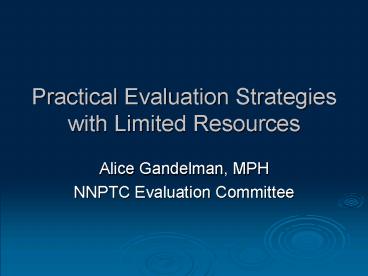Practical Evaluation Strategies with Limited Resources - PowerPoint PPT Presentation
1 / 10
Title:
Practical Evaluation Strategies with Limited Resources
Description:
Practical Evaluation Strategies with Limited Resources. Alice Gandelman, MPH ... Identify provider performance gaps, address them through training ... – PowerPoint PPT presentation
Number of Views:141
Avg rating:3.0/5.0
Title: Practical Evaluation Strategies with Limited Resources
1
Practical Evaluation Strategies with Limited
Resources
- Alice Gandelman, MPH
- NNPTC Evaluation Committee
2
Common TC Training and Evaluation Themes
- Limited time with participants
- To cover subject matter
- To evaluate learning
- Different learning modalities covered
- Didactic
- Affective (e.g., address attitudes/beliefs)
- Skills-based
- Varied knowledge/skill level among training
participants
3
Common Themes, Cont.
- Numerous teaching sites/locations
- Each site semi-autonomous
- Non-standardized training curriculum
- Multidisciplinary training emphases
- Medical providers
- Public health staff
- Disease intervention specialists, program
managers - Community health providers
- Counselors, educators, administrators, outreach
workers - No to evaluate!
4
Why Evaluate?
- Accountability
- For Ourselves
- Identify provider performance gaps, address them
through training - Determine extent to which training results in
increased provider knowledge and skills to
perform better in the workplace - For our Funders
- Ensure that their is invested effectively
- Closing performance gaps, increasing
knowledge/skills - Improving practice in the workplace
5
NNPTC Evaluation Committee Goal
- Improve capacity of NNPTC training participants
who work in multidisciplinary STD/HIV settings to
deliver state of the art clinical management,
behavioral interventions, and/or partner services - Emphasis on improving practice in the field
6
NNPTC Evaluation Committee Activities
- Support Part-specific evaluation activities
- Clinical (Part I)
- Behavioral Intervention (Part II)
- Partner Services (Part III)
- Collaborative efforts (Ask, Screen, Intervene)
- Provide recommendations/protocols to NNPTC
steering committee to enhance or improve national
evaluation efforts
7
Examples of Recommendations
- Standardizing (and collecting) core evaluation
variables across PTCs - Allows for
- analysis of aggregate data
- Collection of additional data variables by site
- Development of outcome objectives to guide
training and evaluation activities - By 2010, 80 of participants who complete ___
training will report increased self efficacy in
conducting risk assessments with their
patients/clients, as measured by at least one
increment on a Likert scale
8
Additional Evaluation Strategies
- Use existing data collection efforts (i.e. PIF
data) to help measure reach of NNPTC training
activities and improvements in provider practice - New funding requires provision of training to
providers in high-morbidity jurisdictions - Follow-up evaluations to determine if skills have
been maintained over time, if practice has
changed/improved
9
Evaluation Methodologies
- Retrospective pre/post design
- Self-assessment of pre/post skills immediately
after training - More accurately measures self assessment of
skills - What about knowledge?
- Demonstrated increases in knowledge post training
are consistent - Less known about acquisition of new skills
- Whether new skills are applied in practice
10
Evaluation Methodologies, Cont.
- Follow-up evaluation activities
- Measure increase in knowledge/skills over time
- Application of skills in work settings
- Barriers and facilitators to applying new skills
in practice - Barriers may not be addressed by training often
due to infrastructure, funding, or other
organizational issues - On-line programs make follow-up evaluation
activities more do-able (e.g., Survey Monkey,
Zoomerang, etc) - provider incentives help too































